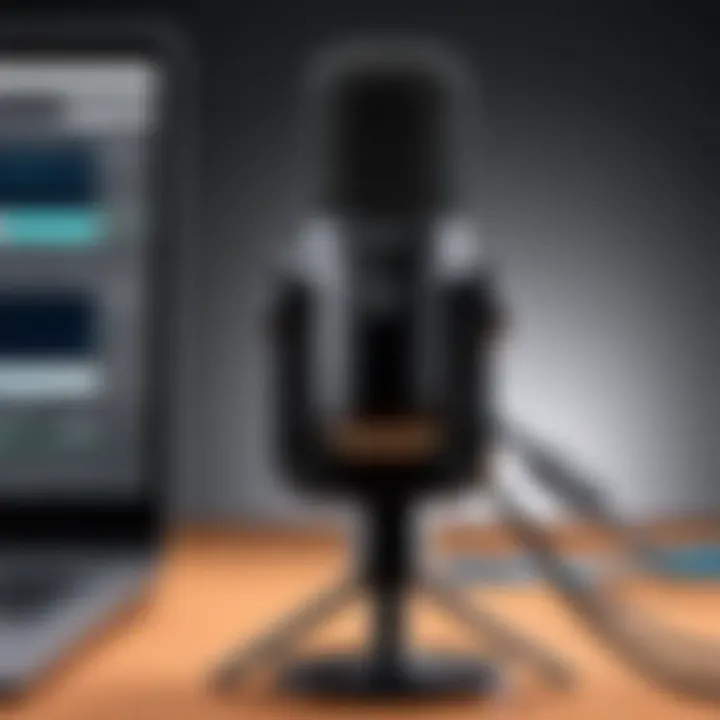Choosing the Best Microphone for Streaming Needs


Intro
Choosing the right microphone for streaming can be more intricate than picking a trendy outfit for a night out. It’s not just about finding something that looks good on your desk; it’s about capturing every nuance of your voice while keeping the technicalities in check. As technology advances, streamers now have an array of options, each with its own specifications, features, and user experiences. This guide is meant to shed light on these choices, making it easier for both seasoned content creators and tech enthusiasts to navigate the soundscape of streaming.
Streaming has become a pivotal avenue for content creation, education, and even community building. The microphone you choose could make or break the way your message is conveyed. Whether you’re gaming, podcasting, or hosting live Q&A sessions, the importance of crystal-clear audio shouldn’t be underestimated. It’s not merely a tool; it’s an extension of your persona. Let’s delve into the key aspects of microphones that are specifically tailored for streaming and highlight what makes them the optimal choice for your projects.
Understanding Streaming Requirements
As technology continues to advance, the realm of content creation and digital broadcasting sees an ever-growing importance placed on streaming. In this light, understanding one’s streaming requirements isn’t just beneficial; it’s essential. Choosing the right microphone can quite literally make or break the sound quality of a stream, impacting both viewer engagement and the overall professionalism of the content. Here, we will delve into the specifics of audio quality, the unique demands of different platforms, and the relationship between content creators and their audiences.
The Importance of Audio Quality
When it comes to streaming, the phrase "good enough" simply won’t cut it, especially for the discerning ears of today’s audience. Audio quality plays a pivotal role. Viewers are likely to tune out if the sound is muffled or filled with background noise. Unlike visual elements, which might catch an audience's eye even in lower quality, poor audio can distract and irritate users; they won't hesitate to leave if they can’t clearly hear the host or the content.
For streamers, investing in a high-quality microphone can yield significant benefits:
- Clearer Communication: Listeners can comprehend the message, leading to higher retention rates.
- Professionalism: High audio quality elevates the overall brand image and instills trust.
- Enhanced Experience: Engaging sound contributes to a richer experience, helping to build a loyal audience.
Different Streaming Platforms and Their Demands
Each platform has its own personality, which directly influences the type of equipment streamers should use. For instance, Twitch, primarily focused on gaming, prioritizes real-time audio delivery, while YouTube caters more to polished production values:
- Twitch: Streamers often require microphones that excel at capturing voice with minimal delay. A dynamic microphone might be suitable here due to its targeted pickup, reducing background noise during intense gaming sessions.
- YouTube: This platform may demand high fidelity sound, making condenser microphones a popular choice for those looking to produce more polished content. Clear and crisp audio supports a professional image.
Each platform's specifics should inform equipment choices, indicating that one size does not fit all when it comes to streaming hardware.
Identifying Your Target Audience
Understanding one’s audience is just as crucial as knowing about equipment. The demographics and preferences of the target audience will have a direct bearing on the content produced:
- Casual Viewers: If your viewer base is more casual, they might not notice subtleties in sound quality. However, even casual users can appreciate a decent audio experience.
- Professionals and Enthusiasts: A tech-savvy audience, conversely, will likely demand utmost quality and clarity in sound. Thus, using advanced microphones and high-quality equipment is paramount.
Ultimately, it’s about maintaining a balance: choosing equipment that meets the needs of both the platform and the audience. A well-informed streamer would not only produce captivating content but would also ensure a seamless audio experience, leaving a lasting impression on their viewers.
"Sound isn’t just what you hear; it’s the foundation of your broadcast and the key to creating an experience that resonates with your viewers."
Types of Microphones for Streaming
When delving into the realm of streaming, understanding the types of microphones available is paramount. Different scenarios call for different tools; hence, choosing the right microphone directly impacts your audio quality. Not every streamer has the same needs, and being aware of these variances can significantly enhance engagement with your audience. It’s not just about talking into a device; it's about ensuring that your voice carries with clarity and presence—creating a more immersive experience for your viewers.
Dynamic Microphones
Dynamic microphones have long been a go-to choice for many streamers. Known for their durability and ability to handle high sound pressure levels, they are particularly effective in noisy environments. What sets them apart is their relatively simple design, which comprises a diaphragm, a voice coil, and a magnet. This simplicity translates into reliability, making them less prone to damage even if you're a bit rough around the edges.
They excel in capturing vocals while minimizing background noise, thanks to their cardioid polar pattern. This directional quality means that sound is primarily picked up from the front, which is just what a streamer needs when there are distractions in the background. Examples include the Shure SM7B and the Audio-Technica AT2020, which both demonstrate a robust build and excellent sound reproduction.
Condenser Microphones
On the flip side, condenser microphones shine in environments where detail and nuance in sound are crucial. They are generally more sensitive than dynamic mics and can capture a broader frequency range. This makes them perfect for vocalists who want to convey emotion or subtle variations in their voice. However, they often pick up ambient noise, which could be a downside if your streaming environment isn’t well-controlled.
Condenser microphones operate with a diaphragm that moves in response to sound waves, requiring phantom power to function. Models like the Blue Yeti and the Rode NT1-A have gained significant popularity among streamers and podcasters for their ability to deliver rich and detailed audio without breaking the bank. Choosing a condenser mic means weighing the importance of audio fidelity against potential noise issues.
Lavalier Microphones
For a more discreet option, lavalier microphones cannot be overlooked. These small, clip-on mics are typically used in interviews or situations where hands-free operation is desired. They excel in providing mobility while maintaining decent sound quality. If you find yourself moving around a set while engaging with audiences or if your streams include guest speakers, a lav mic can be the solution.
While they may not offer the same richness in sound as the larger options, lavalier mics like the Rode SmartLav+ deliver surprisingly solid audio on a budget. They can be a great tool for streamers looking to mix up their content format by adding personal flair with versatile microphone handling.
USB vs. XLR Microphones
Lastly, understanding the difference between USB and XLR microphones is crucial in your selection process. USB microphones are built for convenience, often sporting plug-and-play functionality. They allow streamers to connect directly to a computer, making them a go-to for beginners or those on the move. Models like the HyperX QuadCast are excellent for those who want quality without the complexity of additional equipment.


In contrast, XLR microphones cater to those seeking higher-end sound quality and flexibility. They require an audio interface or mixer, which opens up a range of options for professional sound tweaking that USB connections just can’t match. For example, the Shure SM58 is a classic in the profession, revered for its superior audio quality and durability.
In the end, recognizing the strengths and weaknesses of each microphone type will empower you to make an informed choice tailored to your streaming needs.
"Choosing the right microphone isn’t just about specifications; it’s about matching your voice and situation to the perfect tool."
By weighing these aspects carefully, streamers can enhance not just their audio, but the overall experience of their audience.
Key Features to Consider
When diving into the realm of streaming, the microphone you select can make or break your audio experience. Several features stand out as critical in ensuring that you achieve not just decent, but exceptional sound quality. A microphone isn't merely a tool, it’s an extension of your voice, carrying nuances that can resonate with your audience or completely turn them off. Thus, understanding these key features plays a significant role in making an informed decision during your selection process.
Frequency Response
Frequency response refers to the range of frequencies a microphone can pick up, usually expressed in Hz (hertz). This characteristic dictates how well a mic can transmit sounds of different pitches. For streaming, this becomes vital; you wouldn't want a microphone that skews your voice or misses finer vocal details. A typical human voice ranges from about 85 Hz to 255 Hz, so a microphone with a broader frequency response can capture richer tones, enhancing clarity.
Here's the kicker: microphones with a frequency response that caters specifically to vocal ranges can achieve a more natural sound. Therefore, if you are primarily focusing on voiceovers or music streaming, look for mics that handle frequencies well around that ideal vocal range.
Polar Patterns and Their Impact
Polar patterns are another essential consideration as they define how microphones capture sound from different angles. Common types include cardioid, omnidirectional, and bidirectional.
- Cardioid mics pick up sound mainly from the front, which is great for streamers wanting to isolate their voice from background noise. This can be a lifesaver in less-than-ideal recording environments.
- Omnidirectional mics capture sound from all directions, useful when streaming with multiple speakers or recording ambient sounds, but may also pick up unwanted noise.
- Bidirectional mics capture sound from the front and the back but reject side noises, good for interviews.
Choosing the right polar pattern can significantly alter how your audio is perceived by your audience. If you live in bustling surroundings, for example, cardioid is likely your best bet for clearer sound.
Sensitivity and Noise Levels
Sensitivity gauges how responsive a mic is to sounds. Higher sensitivity can mean better capture of softer sounds, but it can also lead to picking up background noise if not managed properly. This is a crucial element for streamers because nothing frustrates audiences more than hearing popping sounds or murmurs instead of a clear stream. High-quality mics often strike a balance, providing enough sensitivity to convey depth without compromising the overall audio experience.
To mitigate unwanted noise, pay attention to the mic’s self-noise rating (how much noise it generates on its own). For those aiming for a polished sound, choosing a microphone with low self-noise usually leads to a better, cleaner recording.
Connectivity Options and Compatibility
Compatibility is the name of the game. Understanding how a microphone connects to your streaming setup is often more confusing than the technical specs themselves. In the age of technology, microphones can connect via USB, XLR, or even Bluetooth. Each option comes with its own set of advantages:
- USB microphones are user-friendly and great for beginners or those who want plug-and-play convenience.
- XLR microphones offer superior sound quality and greater flexibility for professionals, but they require an audio interface or mixer to connect.
- Bluetooth mics provide mobility and ease of use, but they may introduce lag or interference.
In ensuring the microphone suits your streaming requirements, consider whether you are using a simple setup or a complex audio routing chain that might require professional equipment.
Always check for compatibility with your audio software and recording devices. A good mic that doesn’t work with your setup is like a car without an engine; it looks great but gets you nowhere.
In sum, each of these features—frequency response, polar patterns, sensitivity, and connectivity—contributes significantly to your overall streaming effectiveness. It's worth investing the time to understand them. Remember, the microphone is not just a piece of equipment; it’s a bridge between your content and your audience.
Top Microphone Models for Streaming
When diving into the world of streaming, the microphone you choose can make or break the experience. It’s not enough to simply connect a generic mic and assume it’ll do the job. The various models available offer distinct advantages and drawbacks, tailored to different user needs and preferences. In this section, we will peel back the layers on some of the top microphone models that line the streaming landscape, highlighting their importance in providing clear, high-quality audio, which is crucial for retaining an audience’s attention.
Highly Rated USB Microphones
USB microphones have gained massive popularity thanks to their ease of use and versatility. They’re essentially plug-and-play, requiring no additional equipment or technical know-how to get started. One of the standout models in this category is the Blue Yeti. Renowned for its incredible versatility, the Yeti offers multiple polar pattern options, making it easy to adapt to various environments, whether it's a solo stream or a group session. Here’s why it stands out:
- Multiple Polar Patterns: Cardioid, omni-directional, and bi-directional settings allow users to cater the microphone to their specific streaming needs.
- Built-In Gain Control: Adjusting sensitivity on the fly helps capture optimal audio without external interference.
- Headphone Output: This allows for real-time audio monitoring, enabling streamers to ensure their voice is clear without delays.
Another excellent USB microphone is the Razer Seiren X. Not just for gamers, it serves those needing top-notch audio for podcasts or tutorials. It’s compact, but don’t let that fool you; it’s got a solid build and outstanding sound clarity. This one is particularly useful because:
- Supercardioid Pattern: It effectively mitigates background noise, which can be beneficial in less-than-ideal environments.
- Shock Mount Included: Reduces vibrations, minimizing unwanted noise for a cleaner audio track.
Best XLR Microphones for Professionals
For seasoned streamers and professionals looking to elevate their audio quality, XLR microphones are the gold standard. They typically require an audio interface but offer superior sound quality and flexibility. Among the top choices is the Shure SM7B. This microphone is the darling of many podcasters and streamers.
- Dynamic Microphone: Its dynamic range captures voice intonation brilliantly, adding richness that USB mics can struggle with.
- Built Like a Tank: Not only does it withstand traveling bumps, but ensures durability over years of use.
- Built-In Air Suspension System: This technology reduces mechanical noise, resulting in cleaner output.


Additionally, consider the Audio-Technica AT2035, another trusted microphone in the streaming realm. It’s known for its outstanding clarity and is more affordable than some counterparts without sacrificing sound quality.
- Switchable 80 Hz High-Pass Filter: This feature helps in cutting out low-frequency noise, ideal when you're streaming from home.
- Low Self-Noise: Great for capturing every nuance of your voice, it contributes to professional-caliber productions.
Affordable Options for Beginners
Not every streamer starts with a hefty budget. Luckily, there are microphones that offer great sound quality without breaking the bank. The Fifine K669B is one of the most popular choices among budding streamers. It’s an entry-level USB microphone that doesn’t compromise on essentials.
- Clear Audio Quality: Despite its lower price point, it captures sound that rivals more expensive options.
- Simple Controls: The volume knob on the front allows easy adjustments during streams, keeping everything user-friendly.
Another good option for those just starting is the Samson Go Mic. Portable and portable, it's tailored for streamers on the go. This compact mic attaches easily to laptops and offers decent quality.
- Dual Pattern Selection: Offers flexibility with both cardioid and omni-directional settings, making it handy for various situations.
- Compact Design: Perfect for those who travel or have minimal desk space.
Accessories That Enhance Streaming Quality
When it comes to streaming, having the right microphone is just one piece of the puzzle. The accessories that accompany your microphone play a significant role in optimizing audio quality and ensuring a seamless streaming experience. In this section, we'll delve into various accessories that can vastly improve your setup, enhance sound clarity, and make your streaming experience more professional.
Pop Filters and Windscreens
Pop filters and windscreens might seem like insignificant additions, but they are vital for achieving crisp audio. A pop filter acts as a barrier between your mouth and the microphone, reducing plosive sounds—those sharp bursts of air that can distort your audio, like when pronouncing 'p' or 'b' sounds. Without one, your listeners might experience unwanted pops, making your content less enjoyable.
Windscreens, on the other hand, serve a slightly different purpose. They can help mitigate wind noise for outdoor streams or harsh room acoustics while recording indoors. This ensures that your voice comes through clear and clean, without the unwanted hiss or interference from environmental sounds.
An effective way to choose a pop filter or windscreen is to look for materials that can absorb or deflect sound waves without compromising clarity.
Microphone Stands and Shock Mounts
Stability is the name of the game when it comes to audio quality. Microphone stands help you position your microphone at the ideal height and angle, removing any strain on your neck while streaming. You might be thinking, "Isn’t any stand good enough?" Not really. Some stands are flimsy and can introduce vibrations and handling noise into your audio.
That's where shock mounts come into play. They are designed to isolate the microphone from vibrations caused by movement or even the rumbling of your desk. Shock mounts prevent those little bumps from ruining your pristine audio quality. When selecting a stand and shock mount, consider the weight of your microphone and ensure compatibility with your setup for optimal performance.
Audio Interfaces and Mixers
To further enhance your audio quality, incorporating an audio interface or mixer is an excellent step. An audio interface converts analog signals from your microphone into digital audio, which is essential for high-quality recording. Many streaming professionals prefer audio interfaces for their improved sound quality and greater control over audio inputs and outputs.
Mixers, on the other hand, allow you to blend multiple audio sources, adjust levels, and apply effects, giving you full control over your sound. This is particularly useful if you're incorporating background music or sound effects into your stream.
When looking for audio interfaces and mixers, consider factors like input channels, compatibility with your operating system, and additional features like EQ settings or built-in effects. The right audio interface or mixer can elevate your streaming quality drastically.
"Investing in quality accessories can take your audio from amateur to professional in no time."
In summary, accessories such as pop filters, windscreens, microphone stands, shock mounts, audio interfaces, and mixers are essential for anyone serious about streaming. They not only enhance sound quality but also contribute to a more polished and engaging experience for your audience.
Streaming Setup and Environment
Setting up an effective streaming environment is not just about the microphone you choose; it encompasses a myriad of factors that ultimately affect sound quality and audience engagement. A well-planned setup will assure that your content stands out, avoiding technical distractions that could alienate viewers. Focusing on specific elements like room acoustics, microphone placement, and soundproofing can help turn a simple space into a professional broadcasting studio.
Optimal Room Acoustics
Room acoustics play a crucial role in determining how sound is captured and transmitted. A space that reflects sound too much can make your voice sound hollow or garbled, while a dead room with too much absorption can muffle your audio. Ideally, you want to strike a balance.
- Reverberation Control: Consider soft furnishings like carpets, curtains, and cushions, which can absorb sound waves and reduce echo. Bookshelves and other irregular surfaces can break up sound waves, helping with clarity.
- Room Shape and Size: A square room often leads to more sound reflections than a rectangular one. If possible, opt for a room layout where the distance from walls is greater to minimize unnecessary bounce.
- Reflective Surfaces: Windows and hard surfaces can be problematic. If natural light is a priority, think about how you can soften the reflective surfaces with curtains or other acoustic panels.
Microphone Placement Techniques
The placement of your microphone can heavily influence audio clarity and quality. Positioning it correctly can mean the difference between a crisp sound and a muddled echo.
- Distance Matters: Generally, keeping the microphone between six to twelve inches away will ensure a strong yet balanced audio capture. Be mindful that too close could introduce unwanted plosives, while too far may pick up too much ambient sound.
- Angle Consideration: Position your microphone at an angle that captures sound directly from your mouth. Experiment with positioning; sometimes tilting it slightly can improve the overall quality, depending on your speaking style.
- Height Alignment: Align the microphone at mouth level. This will help maintain consistent sound levels and reduce unintended noise picked up from other sources.
Soundproofing Solutions


Creating a quiet space for streaming is about eliminating distractions from external noises as well as the unintended sounds generated within the room. Soundproofing can seem daunting, but there a few straightforward solutions you can use:
- Acoustic Panels: Installing foam panels can absorb sound waves and help reduce reverb. They come in various designs and can also enhance the aesthetic of your space.
- Weatherstripping: Check for gaps in doors or windows. This inexpensive method can keep outside noise out and maintain a controlled acoustic environment.
- Heavy Curtains: Besides being stylish, hanging heavy curtains can act as sound barriers. They absorb sound and can be drawn back to allow natural light in during less critical streaming moments.
"Investing time and resources into your streaming environment can yield substantial dividends in audio quality, enhancing viewer experience and keeping them engaged longer."
By paying close attention to these aspects of your setup, you're not just improving your audio quality; you're setting the stage for a smoother, more professional experience overall. Getting the acoustics right, mic placement optimized, and soundproofing considered means your audience can focus on what you say, rather than how you sound.
Maintaining Your Microphone
In the realm of streaming, sound quality can make or break an experience. Just as a painter cares for their brushes, streamers must invest time and effort into maintaining their microphones. This not only prolongs the life of the equipment but also ensures that the audio remains crisp and clear during broadcasts. After all, no one wants their audience to suffer through sputtery sounds or annoying pops during a live stream.
Cleaning and Care Practices
Keeping a microphone in good condition involves regular cleaning and sound** care practices**. Dust, grime, and moisture can sneak in and wreak havoc on sound quality. For instance, consider a condenser microphone, which is particularly susceptible to capturing these unwanted contaminants. Here’s a holistic approach to cleaning your microphone:
- Use a soft brush: Gently clean the microphone grille with a soft brush to remove any dust or particles. A makeup brush often works wonders.
- Wipe down often: Use a microfiber cloth lightly dampened with a mild cleaning solution to wipe down the microphone body. This prevents any long-term build-up without damaging sensitive components.
- Pop shield care: If your microphone has a pop filter or windscreen, these should be washed regularly to keep them free from saliva and dirt. You'd be surprised how quickly they can become grimy.
- Store properly: When not in use, keep your microphone covered or in a case. This prevents dust from settling and also avoids accidental mishaps.
Following these basic cleaning steps can shield your investment and maintain the integrity of your sound.
Regular Testing and Troubleshooting
Like clockwork, consistent testing is key to ensuring that your microphone operates at its best. Regular testing can identify issues before they affect your stream quality. Here are vital steps and tips for effective testing and troubleshooting:
- Perform sound checks: Before each session, run a brief sound check. Speak at your normal volume and listen for any irregularities.
- Monitor connections: Loose cables can cause dropouts, so checking connections is paramount. Ensure both XLR and USB connections are secure before beginning any stream or recording session.
- Test in various environments: Sometimes, the room's acoustics can dampen the quality. Test your microphone in different settings to identify possible areas for improvement.
- Use software tools: Several software solutions can help diagnose audio issues. Tools that monitor input levels can provide you with insights on whether the mic is functioning correctly or show if adjustments are needed.
Maintaining a microphone doesn’t just extend its lifespan; it ensures that your audience receives a polished, professional audio experience.
By investing time in cleaning, care, and regular testing, streamers can enhance the clarity of their audio, keep gear in tip-top shape, and ultimately provide a better experience for their audience.
Future Trends in Streaming Microphones
The landscape of streaming continues to evolve, and so does the technology behind microphones tailored for this dynamic environment. As the digital world shifts at a rapid pace, the demand for high-quality audio equipment grows. Therefore, understanding the upcoming trends in microphone technology is crucial for streamers who wish to stay ahead of the curve. This section sheds light on significant advancements and integrations that are shaping the future of streaming microphones, highlighting their implications for content creators and IT professionals alike.
Advancements in Microphone Technology
Over the past few years, we have seen remarkable advancements in microphone technology, characterized by several key developments:
- Noise-Cancellation Features: Modern streaming microphones are increasingly incorporating advanced noise-cancellation technology. This allows creators to minimize background noise, ensuring that the audio remains clear and focused on the speaker. The integration of artificial intelligence in these systems helps distinguish between the primary sound source and unwanted interference, enhancing audio clarity.
- Multidirectional Capabilities: The ongoing refinement of polar patterns provides users with greater flexibility. Manufacturers are now producing microphones that can automatically adjust to the sound source direction. This means that whether one is streaming solo or hosting a panel discussion, the microphone can adapt accordingly, capturing the best possible sound.
- Improved Wireless Technology: Streaming on the go is becoming a norm. Consequently, wireless microphone systems are evolving, offering better range and reliability. New protocols ensure that latency is kept to a minimum, providing a seamless experience for both the streamer and the audience.
"Innovative microphone technology is not just about capturing sound, it's about creating an immersive audio experience that connects streamers with their audience.”
These advancements not only optimize the user experience but may also foster a new generation of content that relies heavily on high-definition audio.
Integration with AI and Smart Technologies
The integration of artificial intelligence and smart technologies into streaming microphones signals a new era for content creators. The importance of this trend can be summarized through the following aspects:
- Smart Audio Adjustments: With AI algorithms, microphones can analyze the audio environment and adjust sensitivity and gain settings to capture the best possible sound. Streamers can focus more on their content without worrying about mic settings, enhancing their performance.
- Real-Time Effects: Some modern microphones are embedding software solutions that allow streamers to apply effects in real-time. This can range from voice modulation to echo management, greatly expanding the creative possibilities during live broadcasts.
- Compatibility with Smart Devices: Many of today's microphones are designed to integrate smoothly with smart home technologies and other devices. This merger allows users to control their audio settings using voice commands or mobile apps, offering a more intuitive user experience.
Epilogue and Recommendations
As we reach the final stretch, it is good to reflect on the road we’ve traveled through the intricate world of streaming microphones. This section brings together the threads of our discussion, emphasizing why selecting the right microphone is not merely a matter of preference but directly impacts the clarity and professionalism of your content. The choices made here can dictate the way your audience perceives you.
Summarizing Key Points
- Audio Quality Matters: As discussed earlier, audio quality is paramount for streaming success. A poor microphone can hinder even the most captivating content. High-quality audio keeps the audience engaged and conveys professionalism.
- Matching the Microphone to Platform: Different platforms may require distinct microphone qualities; streamers must tailor their choice to the specific demands of each platform. For instance, a gamer on Twitch may need a different setup than a podcaster on Spotify.
- Choosing the Right Type: Knowing the right type of microphone can elevate your setup significantly. Each type—be it dynamic, condenser, or lavalier—has its own strengths and weaknesses. Understanding these can empower better decision-making.
- Essential Features: Key features like frequency response, polar pattern, and connectivity options play a pivotal role in microphone selection. Ignoring any of these could lead to compromises in sound quality.
- Proper Accessories: Utilizing appropriate accessories can enhance the microphone's effectiveness and overall quality. Items like pop filters, shock mounts, and audio interfaces should not be an afterthought.
Final Thoughts on Selection Process
In summation, the selection process is crucial and should not be rushed. Consideration must be given to circumstances such as your intended use, the environment, and your budget.
When deciding, always remember:
- Do your research. Read reviews and consumer feedback on specific models.
- Test when possible. If you're purchasing offline, strive to try out different microphones to gauge their performance.
- Future-proofing. Think ahead about your streaming ambitions as microphones can be a long-term investment.
By keeping these considerations in mind, aspiring streamers and seasoned content creators alike can enhance their audio experience, ensuring their voice stands out in the digital crowd.
Choosing the right microphone is about more than just sound; it’s about creating a connection with your audience, where clarity, professionalism, and engagement reign supreme.



